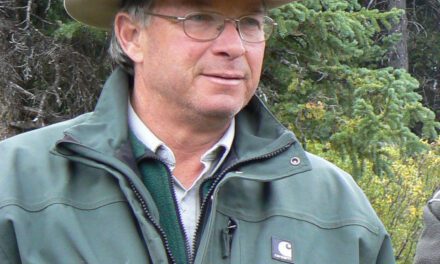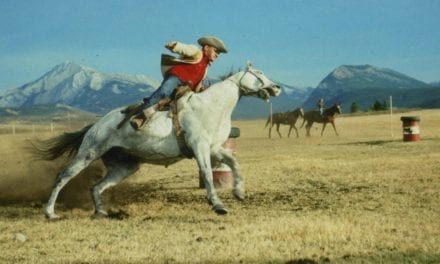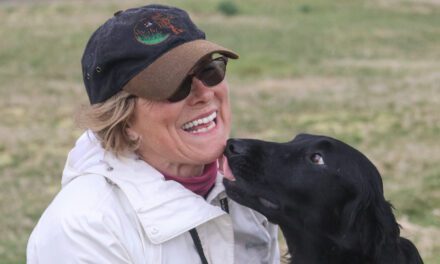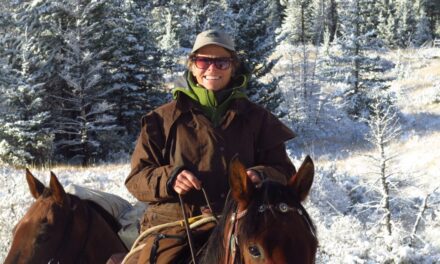(35:01) Rod – You mentioned bears. Was there other wildlife in and around the yard? What about wolves.
(35:07) Connie – Cougars. Remember that trapper?
(35:12) Peggy – Clarence Long.
(35:14) Connie – He brought these cougar dogs. Really good dogs, eh. The old yellow tom cat chased the cougar dogs’ right out of the yard. So we wondered how good of cougar dogs they were you know!
(35:25) Peggy – Clarence had been bragging about his cougar hounds!
(35:31) Connie – Yeah, he was proud of them, but he was kind of embarrassed when the old yellow tom chased them.
(35:38) Rod – So your dad actually brought this fellow in?
(35:42) Peggy – Well, if anybody went through the yard they’d come into the house and visit. My mom would make them a coffee.
(35:47) Connie – But he had a trap line up from us.
(35:49) Rod – I meant to deal with the cougar, they brought somebody in?
(35:53) Peggy – Oh no. He just had a trap line and he would come through.
(35:58) Ann – He was a cougar hunter. I have a picture.
(36:03) Peggy – But was he special brought in to get the cougars from around the place? He was a guide and outfitter was he?
(36:09) Ann – No, he just had a trap line up above the ranch.
(36:14) Connie – Mom has a picture of his little cabin. I guess he used to have a lot of canned foods because the cans that he threw out were right up to the window, all the way around the cabin.
(36:28) Rod – What about horseback riding, did you do a lot?
(36:29) Connie – Oh, we had to. We had to know how to ride horses…It wasn’t my favorite thing.
(36:38) Rod – And your dad took you on sleigh rides?
(36:40) Connie – We had a haystack wagon. He would put hay in there and we would ride in the hay. He had a bobsleigh and we went in that too. Sometimes it was in the hay, you know the wagon that they had all the hay in to transport it. We would ride in there up on the top, remember?
(37:00) Peggy – Yeah, it was too high for me. It scared me. I was so little you know. That was really high and I was scared that I would fall off.
(37:07) Rod – So tell us about the dog team. Didn’t your dad…start a dog team at the ranch?
(37:18) Ann – It was because of Jack Schulte who was helping Fred at the time. When Lloyd turned 65, the government called him into Banff, called him into the office and said, “That’s it. He wasn’t the foreman anymore.” So Fred got the foreman job. Fred had a fellow helping him. His name was Jack Schulte. Jack’s uncle had a dog team up north and he worked with his uncle a bit. He was a rider too, a rodeo rider. He was really interested in dogs and we had a few. Well, then we got more. The superintendent in Banff, I just can’t think of his name. He was always having trouble with his dog and the wardens were always picking him up and putting him in the pound. Then the superintendent had to retrieve him. Well, he got kind of fed up with this so he thought the ranch would be a good place to put him. He didn’t ask us or anything…
(38:55) Peggy – Which dog was that?
(38:56) Ann – Major.
(38:57) Peggy – Oh, that was old Major.
(39:00) Ann – The thing was with Major, he got blinded in one eye. He couldn’t see that well anymore. He was a good dog though. Every time we thought the bears were coming we put old Major up in the loft of the barn, so he wouldn’t smell them and he would be safe there.
(39:31) Rod – So Fred made up a harness.
(39:34) Ann – Yes, Fred and Jack made the dog harnesses and the collars…I think they had seven collars that they did. They stuffed them with deer hair because Jack thought that was the best. That’s what his uncle used up north on his trap line. We had a Samoyed dog, a white Samoyed and her name was Lady. I don’t know if Jack brought her, or just how that happened. But anyway she had seven pups. So these pups grew up to be the dog team, the first dog team.
(40:43) Connie – Well the very first one, he had three different dogs. Remember in the very beginning? He hooked them up and they started bucking like horses! That was at the ranch.
(40:55) Peggy – There was a collie dog, somebody’s collie dog…Was Major one of them? I am not sure. And Lady, something like that.
(41:05) Ann – I think Lady was Jack’s dog…Then the superintendent’s dog.
(41:18) Peggy – It was a collie dog and I think that it must have been one of the guys’. Lloyd’s?
(41:29) Rod – So he would take the dog team into the park? Up the Red Deer River and use it in the wintertime.
(41:37) Ann – When Fred was finished at the ranch and the reason that he was finished was the chief warden came out from Banff and asked him I guess if he wanted to be a park warden because they had a station that was open. It was Saskatchewan River Crossing. So okay, he thought that that was pretty nice and we did too. We thought it was just wonderful. And still Fred would have horses at the station. He wouldn’t have as many, but he thought, yes we’d go. He had the dogs by then, the dog team. Jack Schulte had gone from the Ya Ha Tinda then. We were quite excited when they said that because first of all it would give Fred his grade one warden status. Secondly, we would be on a regular warden station. The fellow that was on that station at that time was Wally McPhee.
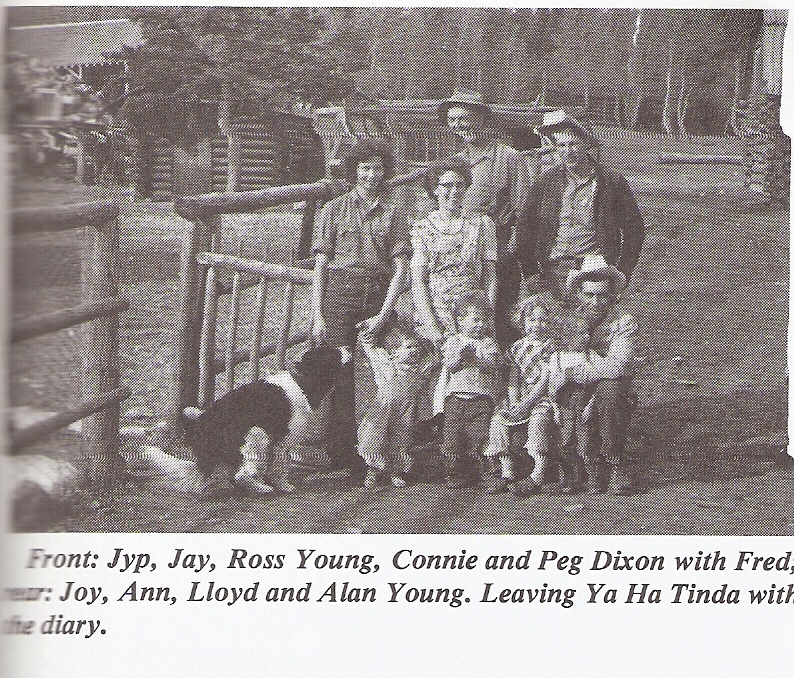
Photo from Ann Dixon’s book Silent Partners: Wives of National Park Wardens
(43:26) Rod – He was moved to town, closer to Banff somewhere?
(43:30) Ann – Well, he stayed there for a while with Fred.
(43:33) Rod – Yeah, there are two houses there.
(43:36) Ann – Fred was a grade one and Wally would be the grade two then.
(43:59) Rod – So Fred would use the dog team then to patrol up the Saskatchewan, up to Howse Pass probably.
(44:08) Ann – Oh yeah.
(44:08) Rod – He would do some of those trips. And he’d haul some of the materials needed at the backcountry cabins.
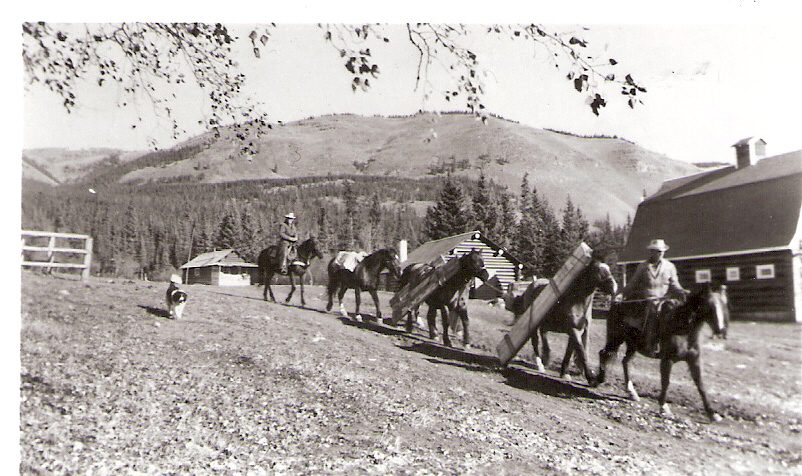
Fred Dixon and Allan Young packing lumber to Indianhead for the new fire shed – Photo courtesy of Ann Dixon
(44:17) Ann – He was supposed to check the phone lines as he went along too. If the snow got too deep for the dogs, he would use his snowshoes and break trail for them.
(44:35) Rod – So you liked the lifestyle at Saskatchewan Crossing then?
(44:38) Ann – Oh yes, and it was just at the time when they were building that road from Lake Louise to Jasper, that highway. They had three road crews. One was near Lake Louise, the other one was at Bow Summit…and the third one was up closer to the Ice Fields.
(45:09) Rod – Right at Camp One there…
(45:13) Ann – They had Camp One, Camp Two and Camp Three. Fred used to buy dog feed by the one hundred pound sack. I don’t know if it weighed one hundred pounds, but it was big bags. And he would get scraps from the camps, bacon fat and meat scraps…and that is what he used to feed the dogs. He mixed the dog feed with it. Because it takes a lot of food for that many dogs. He had seven then at the time.
(45:54) Rod – Now this would have been the early 1960s? That was when the road was rebuilt. The original road bed was redesigned during that period…actually wasn’t that when the bungalow camp was rebuilt…
(46:15) Peggy – What do you mean bungalow camp?
(46:18) Rod – Well the restaurant and hotel.
(46:21) Peggy – Oh Schmied’s. Mr. Schmied owned it then. At Saskatchewan River Crossing.
(46:27) Rod – What about your memories at Saskatchewan River Crossing?
(46:35) Peggy – Yeah, we’ve got quite a few.
(46:37) Connie – One of the things I remember at the Crossing is about a bear. We had a teepee set up because they used to use teepees when they would go out and stay places (in the backcountry). They had poles different places. So it was set up in the yard and Peggy and I were sleeping in there. We were sleeping one on each side….We had gotten into bed and all of a sudden there was noise and crashing around…this little cub came and he ducked under the teepee door and ran in. He stopped dead center in the middle and he just kind of looked around and then he started to go. I looked at Peggy and I said, ‘Where is the mom?” He ducked under the back and we just kind of waited there frozen to see if she was going to come flying in after the cub. But he had ducked under the back and went out. I remember that at the Crossing!
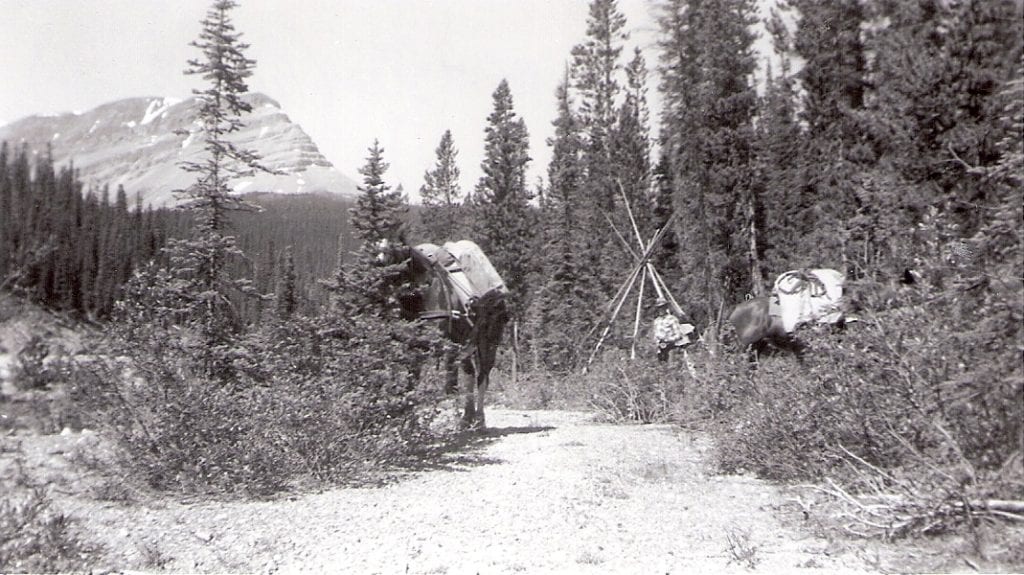
Fred Dixon setting up an overnight camp in the Saskatchewan River district 1958 – Photo courtesy of Ann Dixon
(47:28) Rod – So you were excited to move to the Crossing?
(47:30) Connie – I liked the life, it didn’t matter where it was… and I liked the dogs. They were my favorite thing of anything…
(47:42) Connie – It was just my dad and I. I don’t know why that time. I thought it would be really cool, I don’t think that I was that tall, but I wanted to learn how to drive the dogs. So he says, “Oh, okay.”
(47:52) Ann – That was the ice on the Saskatchewan River.
(47:53) Connie – That’s right, because it was easier traveling on the open frozen river. He told me, “Always trust the dogs when they are on the river because they will know if there is a crack.” Because he didn’t one day and he made them go. The river cracked and it started to cave in. So he said, “You should always trust them because they know!” I thought, “Oh, this would really be cool, I would like to drive the dogs.” “Okay.” He says and he got into the toboggan and then I got out. The toboggan was big and they were running. He said, “Watch the river.” Because they have these circles and it went kind of down like this (demonstrating) when it froze. Well, I guess I didn’t watch good enough because all of a sudden the toboggan went like this and pulled me down into this hole. He didn’t get mad or anything. He just quietly said, “I told you, you had to watch.” Like that was kind of how he talked to you when you didn’t do what you were supposed to.
(48:47) Rod – What about your dad’s way with animals? That was something that impressed me when I worked with Fred.
(48:52) Connie – One thing that he taught us at a very young age, and it is hard for me to understand people who don’t understand it because it just became part of us, he always used to say, “You have to think like the animal does before the animal thinks it.” He said, “You have to learn how each animal and each species thinks because they are all different…You got to know them and you watch what they do. You watch how they move…and learn how they think. That is how you survive.” That is what he taught us. To this day it is just second nature. You just look at animals and you think, “Okay, if I was that animal I would think this.” Different times with bears, like when Peggy and I were in different situations, I would think “If I was the bear this is how I would think.” We never got into any issues with bears, any bad issues.
(49:46) Peggy – Well Connie was really the bear woman and I just clung on to her. She would just say, “Come on Peggy.” I would just get beside her and she would hang onto me and away we would go. She just knew.
